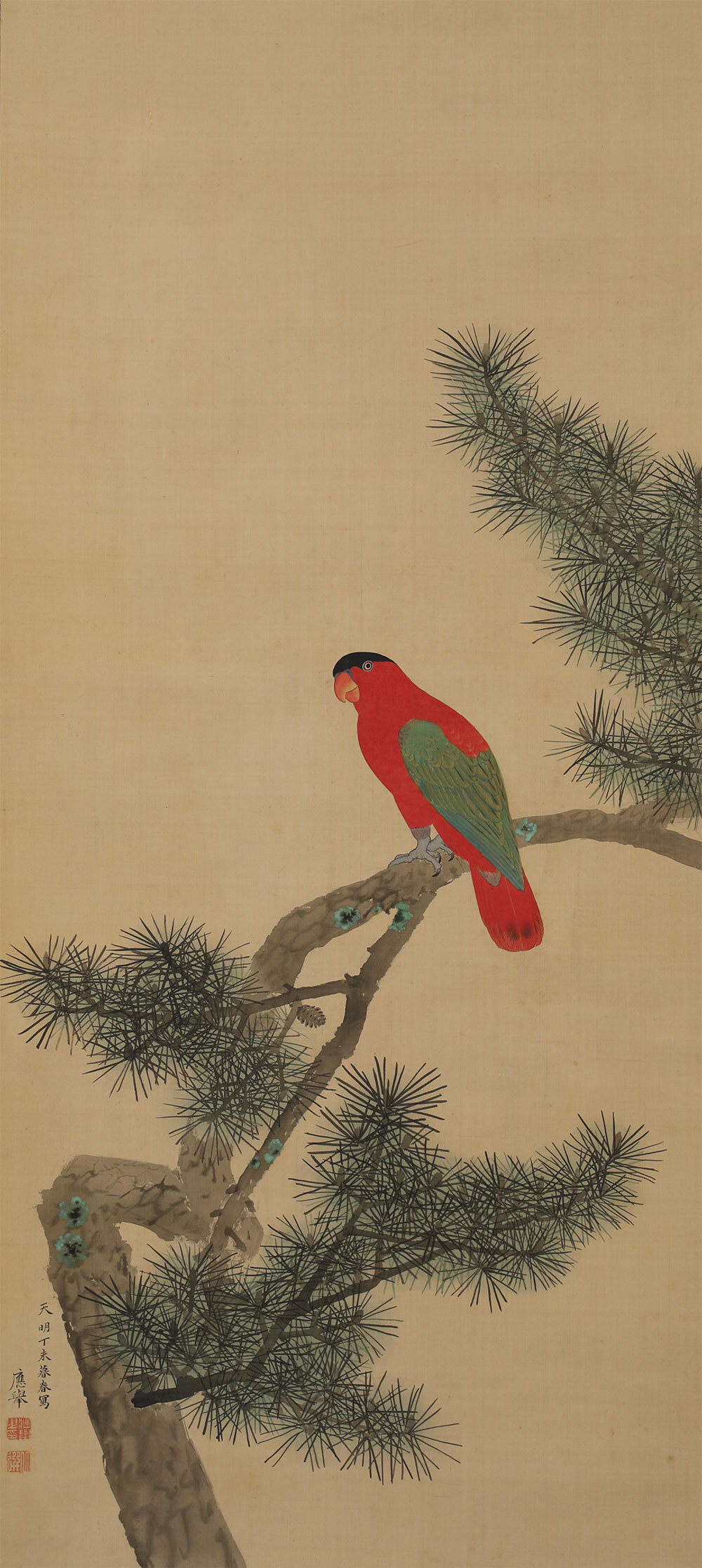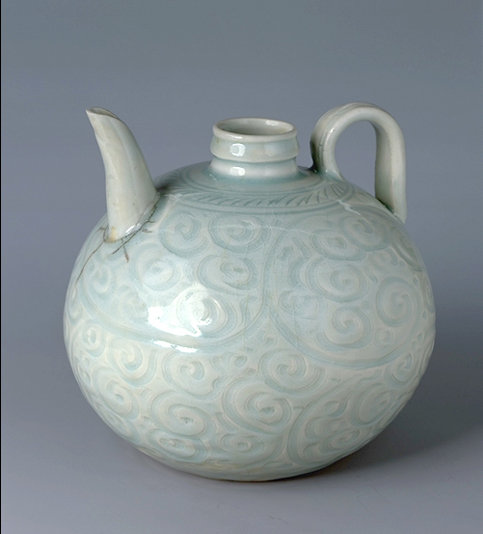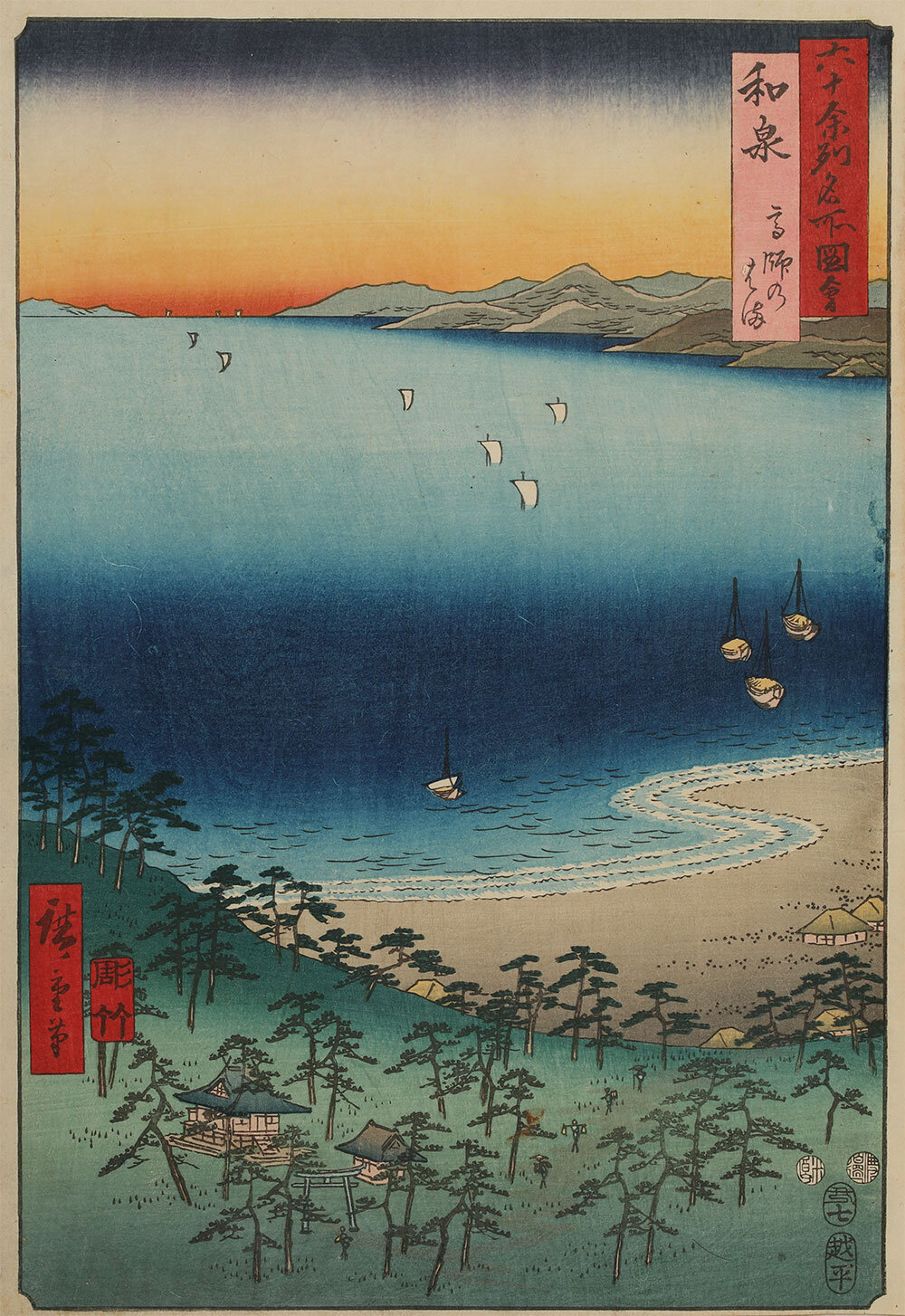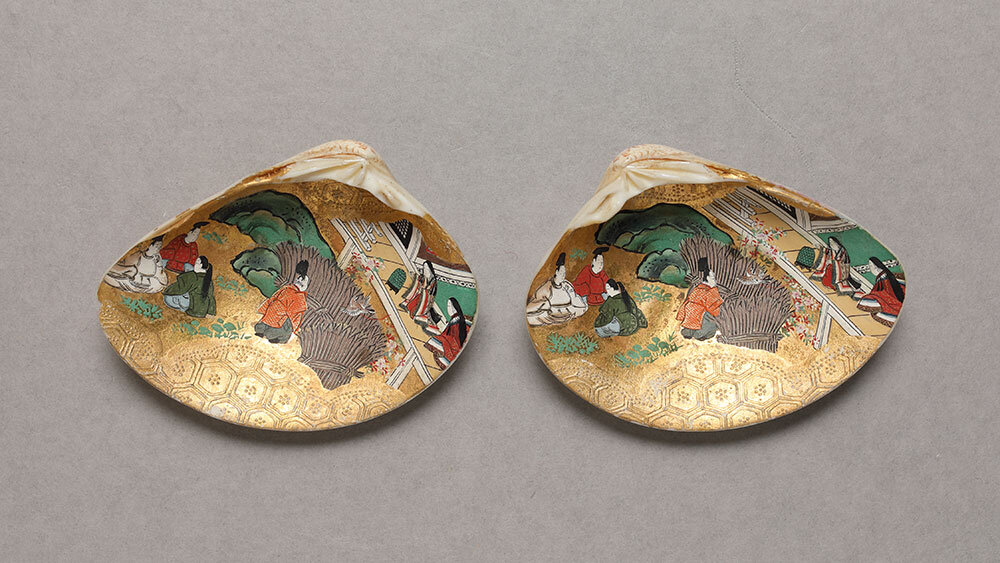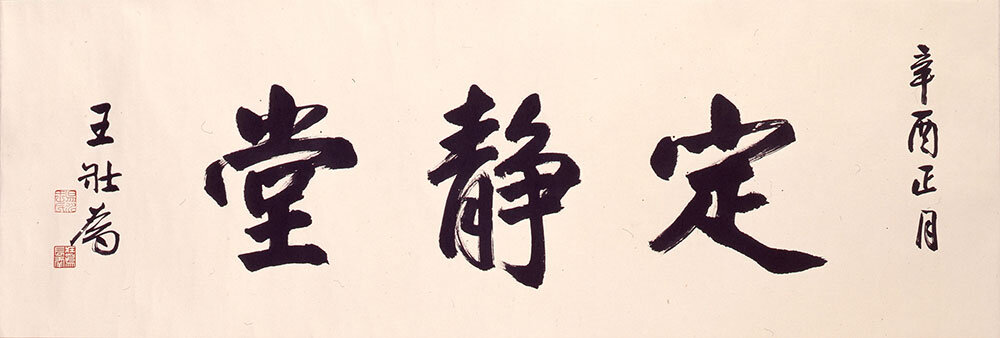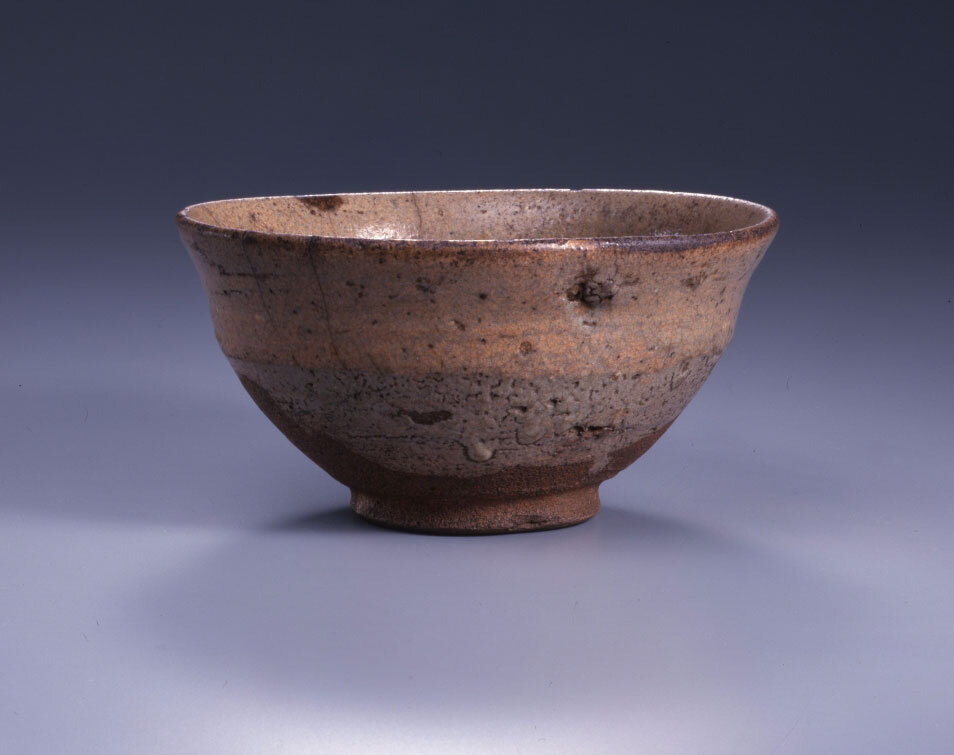本年度展覧会案内
開催中の展覧会
源氏・応挙・若冲 ―近世絵画と久保惣の名品―
令和6年4月21日(日)〜6月16日(日)
本展では、和泉市久保惣記念美術館のコレクションの中から桃山時代から江戸時代に制作された近世絵画を取り上げ、当館を代表する国宝2点をはじめとする名品とともに陳列します。近世絵画は、特徴的な表現方法を有する作品に着目し、第一に桃山時代の土佐派を代表する絵師土佐光吉が絵を描いた重要文化財「源氏物語手鑑」(全80枚中、前後期で8枚ずつ計16枚)の伝統的なやまと絵の絵画表現、第二に江戸時代中期の京で活躍した円山応挙の写生的な画風、第三に応挙と同時期に同じ京で腕を揮った伊藤若冲の拓版技法によるモノクロームの表現、という三つの切り口で紹介します。とくに円山応挙は、昨年度に新規購入した「老松鸚哥図」を初出陳します。
Genji, Ōkyo and Jakuchu―Pre-modern Art Gems―and Masterpieces from the Kuboso Collection
April 21 (Sun.), 2024 – June 16 (Sun.)
This special display from the museum’s collection will comprise of paintings that exemplify three distinctive styles produced during Japan’s pre-modern era (16th–19th centuries), together with two of our signature National Treasure pieces from the Heian Period (8th–12th centuries). The pre-modern paintings section features the traditional Yamato-e style depicting the Tale of Genji, the sketching style of Okyo, and the monochrome ink paintings of Jakuchu. The Yamato-e style will be represented by 16 pieces from An Album of Illustrated Scenes from The Tale of Genji (8 pieces each during the first and the second periods from 80 pieces in total). This album is an Important Cultural Property and was created by Tosa Mitsuyoshi, one of the leading painters of the Tosa School during the Momoyama Period (1573–1615). The second style is that of Maruyama Okyo and the third of Ito Jakuchu, known for developing a technique of ink-rubbing on woodblocks, both of whom were active in Kyoto during the mid-Edo Period (around the 18th century). Okyo’s Old Pine Tree and A Parrot, a recent acquisition made last year, will be exhibited in our museum for the first time.
Main Display Items
A Competition comparing coupled poems by Poetic Immortals (National Treasure), Heian period
Celadon vase with phoenix handles, known as “Bansei” (National Treasure), Southern Song Dynasty
An Album of Illustrated Scenes from The Tale of Genji (Important cultural property), by Tosa Mitsuyoshi, Edo period (1612)
Shrike in Barren Tree (Important cultural property) by Miyamoto Musashi, Edo period
Sketching from Life by Maruyama Okyo, Edo period
Old Pine Tree and A Parrot by Maruyama Okyo, Edo period
2024年度開催予定の展覧会
六十余州名所図会 ―広重と巡る日本の風景―
令和6年6月30日(日)〜8月25日(日)
歌川広重が晩年に制作した「六十四州名所図会」全70点(目録含む)を展示します。この作品は晩年の広重が積極的に制作した縦構図の風景画で日本の名所が描かれています。描かれる土地の名物などの情報を加えた解説を全点につけ、日本の名所を旅する雰囲気を楽しんでいただく展示とします。
遊びのすがた ―工芸と絵画で見る玩具の美術―
令和6年9月15日(日)〜11月17日(日)
おとなや子どもが楽しんできた遊びに使われた工芸品、ならびに遊びのありさまを描いた絵画で構成する展覧会です。江戸時代の作品を中心に、囲碁、将棋、かるた、羽子板、人形などの遊具と、屏風等に描かれた絵画を合わせて展示します。遊具に見られる工芸品ならではの美しさや遊びに興じる人々の表情やしぐさの描写を絵画として鑑賞していただくとともに、伝統的な遊びについても改めて知る機会とします。国内の博物館施設、個人所蔵家などから作品を借用し、当館所蔵品も含め約90点を展示します。
中国絵画の清華 ―魅力あふれる定静堂コレクション―
令和6年12月8日(日)〜令和7年2月2日(日)
当館が所蔵する中国美術の中から、平成12(2000)年に林宗毅氏(1923-2006)より和泉市に寄贈された定静堂コレクションのうち、清時代から近代にかけて制作された絵画を展示します。 林氏は台湾三代名家の筆頭とされる林本源家の出身で、自身のコレクションに生家の建物に因んだ「定静堂」の名を用いられました。これらの定静堂コレクションと呼ばれる書画作品群は、当館以外に東京国立博物館と台北の国立故宮博物院にも寄贈、所蔵されています。 本展覧会では、伝統的な中国絵画を重んじた画家や、西洋や日本の絵画を学びその影響を受けた画家たちが生み出した個性豊かな作品を通じて中国絵画の多彩な魅力をお楽しみいただきます。
茶道具 ―久保惣コレクションの優品―
令和7年2月15日(土)〜3月23日(日)
美術館の茶室耐震補強工事(1期)が令和6年度に完了することを記念して開催します。桃山時代、江戸時代の茶碗、茶入を始め、釜、水指、向付、茶杓、棗などの各種の茶道具を陳列し、美術館が所蔵する茶道具の優品を鑑賞いただく機会とします。国指定品の国宝 青磁 鳳凰耳花生 銘万声、重要文化財 唐津 茶碗 銘三宝なども合わせて出陳し、茶室工事完了を飾る展覧会とします。
Scheduled Exhibitions
Famous Views of the Sixty-odd Provinces―Visiting Famous Locations in Japan with Hiroshige
June 30 (Sun.), 2024 – August 25 (Sun.)
This exhibition features all 70 pieces (including the catalog) in the series of Famous Views of the Sixty-odd Provinces created by Utagawa Hiroshige in the later years of his life. They are prime examples from the large body of work he produced at this time depicting well-known landscapes all over Japan. A description of the individual work will accompany each piece, as well as additional information, such as local specialties at the location. This will provide visitors with the opportunity to not only enjoy his work, but also feel as if they are actually there.
Main Display Items
Famous Views of the Sixty-odd Provinces: Takashi Beach in Izumi Province by Utagawa Hiroshige (1853)
Famous Views of the Sixty-odd Provinces: Idemi Beach, Sumiyoshi in Settsu Province by Utagawa Hiroshige (1853)
Famous Views of the Sixty-odd Provinces: Ama no Hashidate in Tango Province by Utagawa Hiroshige (1853)
Famous Views of the Sixty-odd Provinces: Kannondo, Abuto in Bingo Province by Utagawa Hiroshige (1853)
Famous Views of the Sixty-odd Provinces: Bonito Fishing at Sea in Tosa Province by Utagawa Hiroshige (1855)
Famous Views of the Sixty-odd Provinces: The Two-Sword Rocks at Bo Bay in Satsuma Province by Utagawa Hiroshige (1856)
Different Ways of Having Fun―The Art of Toys and Games in Handicrafts and Paintings
September 15 (Sun.), 2024 – November 17 (Sun.)
The aim of this special display is to offer a learning opportunity on how both children and adults have played with toys and games traditionally in Japan. The exhibits include handcrafted toys that were actually used, in addition to paintings that depict people having fun with toys. The items on display will number around 90 pieces selected not only from the museum’s own collection but also on loan from other museums and personal collections in the country. The majority of the exhibits are from the Edo Period, including dolls and games, like go, shogi, karuta, and hagoita, in addition to paintings on different surfaces, including folding screens. We hope this will also be a good chance for visitors to appreciate the beauty of the art characteristically seen in handicrafts such as toys, as well as in the people’s faces and actions having fun as portrayed in paintings.
Main Display Items
Mulberry go board with an autumn-leaves maki-e design, Meiji period, Kuboso Memorial Museum of Arts, Izumi
The Elegance of Chinese Paintings―Extraordinary Teiseido Collection
December 8 (Sun.), 2024 – February 2 (Sun.), 2025
Drawing on the large Chinese art collection of our museum, this exhibition features paintings from the Qing Dynasty Period to the modern day, all selected from the Teiseido Collection donated to Izumi City by Munetake Hayashi (1923–2006) in 2000. Hayashi was actually born into the Lin Ben Yuan family, one of the three most powerful families in Taiwan. However, he used the name Teiseido, one of the buildings on his family’s estate, for official purposes, such as business dealings and art collection. A number of items from the Teiseido Collection have been donated to the Tokyo National Museum and the National Palace Museum in Taiwan, in addition to our museum. This exhibition will showcase the diverse world of Chinese paintings through unique and distinctive art pieces created by artists who followed the traditional methods of Chinese art and those who were also inspired by western and Japanese styles.
Main Display Items
Easy Life on Autumn Mountain by Fang Shishu, Qing Dynasty (1750)
Spring Sun on Rocky Valley by Dai Xi, Qing Dynasty (1848)
Thatched Cottage on Autumn Mountain by Puru, Republic of China (Early 20th century)
Bamboo by Wu Changshuo, Republic of China (1915)
Lin Family’s Flower Garden by Huang Caisong, Republic of China (1980)
Tea Ceremony Utensils―Remarkable Works from the Kuboso Collection
February 15 (Sat.), 2025 – March 23 (Sun.)
To commemorate completion of the first phase of the seismic reinforcement work for the tea ceremony room of the museum in 2024, this exhibition will showcase the art of tea ceremony utensils from the museum’s collection. The displays include tea bowls and tea containers from the Momoyama and Edo Periods (16th–19th centuries), as well as other utensils, such as kettles, water containers, dish bowls, tea scoops, and tea caddies. Other exhibits include a National Treasure (Celadon vase with phoenix handles, known as “Bansei”) and an Important Cultural Property (Teabowl, Karatsuware, known as “Sambo” (Three treasures)) from the museum’s collection.
Main Display Items
Celadon vase with phoenix handles, known as “Bansei” (National Treasure), Southern Song Dynasty
Teabowl, Karatsuware, known as “Sambo” (Three treasures) (Important cultural property), Momoyama period
Black tea bowl “First Frost” by Chojiro, Momoyama period
Tea caddy of katatsuki (angular shoulder) form, Bizen ware known as “Ima-Hotei,” Momoyama period
Lacquer natsume decorated with maki-e design of autumn fields, Edo period
Tea Kettle by Tsuji Yojiro, Momoyama period




